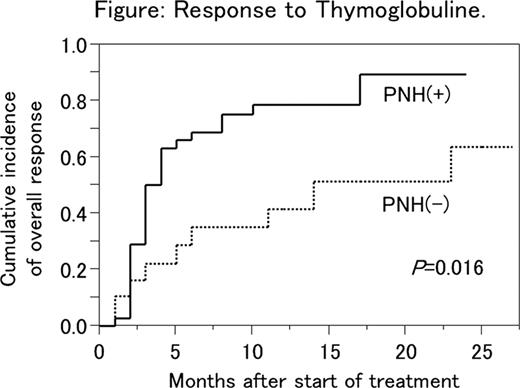Abstract
Abstract 1339
Thymoglobuline (TG), a rabbit anti-thymocyte globulin (ATG) preparation which has more potent immunosuppressive effects than horse ATG Lymphoglobuline (LG), has been shown to be as effective as LG as both first and second line immunosuppressive therapy (IST) for aplastic anemia (AA) by several retrospective studies. However, recent prospective studies from the U.S. and Europe have shown a lower effectiveness of TG compared to horse anti-thymocyte globulin (ATG). The conflicting results may be due to the heterogeneity in the pathophysiology of AA or in the ethnic backgrounds of the patients evaluated. Small populations of glycosylphosphatidylinositol-anchored protein (GPI-AP)-deficient (GPI-AP−) blood cells are detectable in approximately 60% of patients with newly-diagnosed AA, and are associated with a good response to LG (Blood, 107: 1308, 2006). TG may have comparable effects on LG if the study subjects are limited to AA patients possessing GPI-AP− blood cells. Objectives/Methods: To evaluate the effectiveness of TG in Japanese patients with AA, we retrospectively analyzed the outcomes of TG therapy in 57 patients (25 males and 32 females) with AA (40 with severe AA and 17 with non-severe AA) aged from 17 to 84 (median 58) years. Peripheral blood obtained before therapy was examined for the presence of GPI-AP− cells using flow cytometry with liquid fluorescent aerolysin, which can accurately determine the percentage of GPI-AP− granulocytes, erythrocytes, and monocytes at percentages of less than 0.01%. The cut-off values were defined as >0.003% for granulocytes, >0.005% for erythrocytes, and >0.01% for monocytes based on the analytical results of 57 healthy individuals. Results: The cumulative rate of response after 6 months of TG therapy was 59%. Significant increases in the GPI-AP− cell percentages in at least one of the three lineages were detected in 38 (67%) of the 57 patients before therapy. The response rate in patients with increased GPI-AP− cells (PNH+ patients, 69%) was significantly higher than that in patients without GPI-AP− cells (PNH− patients, 35%, P=0.016). Seventeen percent of PNH+ patients achieved complete remission (CR) within 1 year, while only 12% of PNH− patients achieved a CR. 97% of PNH+ and 84% of PNH− patients were alive at the median time of 1 year after the therapy. The response rate in PNH+ patients was comparable to that in PNH+ patients treated with LG (70%) in our recent prospective study. Conclusions: TG is therefore considered to be as effective as LG in Japanese adult patients with AA, particularly in PNH+ AA patients where immune pathophysiology is definitely involved. Alternative therapies may thus need to be considered for PNH− patients.
No relevant conflicts of interest to declare.
Author notes
Asterisk with author names denotes non-ASH members.


